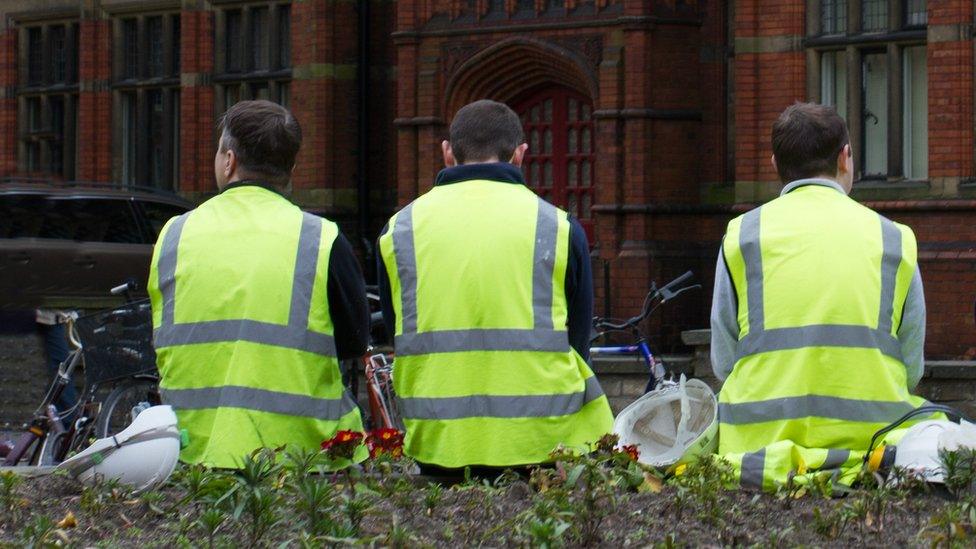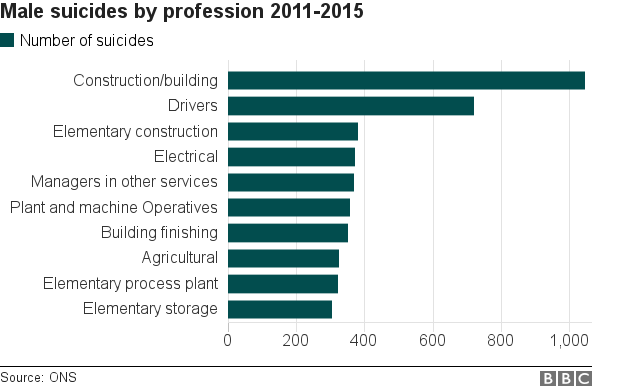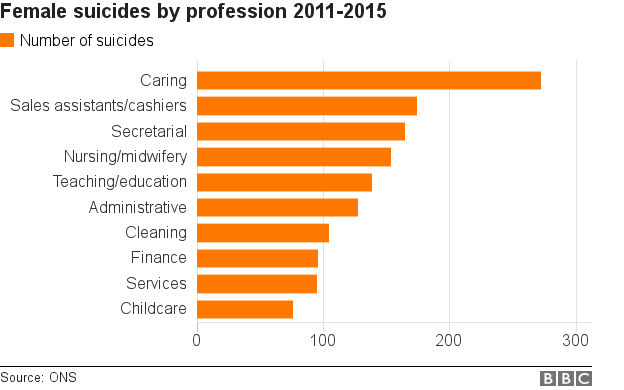Suicide risk greatest for low skilled male workers
- Published

Construction and building trade workers accounted for the largest number of suicides among professions
Men working in the lowest-skilled occupations and women in culture and health jobs are at the highest risk of suicide, according to new research.
Figures also show construction workers killed themselves at a rate three times higher than the male average.
For women, people in culture, media and sport had a rate 69% higher than the female average.
The Samaritans said more understanding would help to target support to those most at risk.
The Office for National Statistics referred to previous studies, which found job security and low pay increased the risk of suicide.
The report was based on 13,232 deaths from suicide registered in England between 2011 and 2015 among people aged 20 to 64, where the deceased's occupation was known.
About four in five (10,688) were men.

Men working in skilled trade occupations had the second-highest risk among the major occupational groups, the ONS said. They accounted for 29% (3,059 out of 10,688) of all male suicides.
The raw numbers showed 1,047 male suicides were of people in the construction or building trade. However, this does not take account of the number of people working in the professions.
Among women, those working in culture, media and sport as well as health professionals had the highest rates.
Women in culture, media and sport occupations had a rate 69% higher than the national average for women while health professionals were 24% higher.
In raw numbers, the most suicides among women were in the caring professional services - 273 between 2011 and 2015.

The figures were compiled by the ONS, which worked with David Gunnell, Professor of Epidemiology at the University of Bristol. The study was commissioned by Public Health England.
Ruth Sutherland, chief executive of Samaritans, said: "Suicide is complex. There is never a single reason or circumstance that leads to a person taking their own life, so all additional insight into suicidal thoughts and behaviours is to be welcomed.
"The more we know, the more we can target resources and support to those most at risk."
She said the organisation was now working with the construction industry.
Duncan Selbie, chief executive of Public Health England, said: "Suicide is the leading cause of death for men under 50, and more women are taking their own lives each year. Death by suicide is never inevitable, but for a person who is overwhelmed by feelings and events that appear insurmountable, it can seem like the only answer.
"People who die from suicide are usually not in contact with health services, and often push through in silence as their ability to cope deteriorates. With more than two-thirds of adults in employment, the workplace offers an opportunity to reach people who need extra support.
"I urge all employers, large or small, public or private sector to treat mental health as seriously as physical health. Early action can stop any employees reaching a desperate stage. Simple actions can make a huge difference - talking with a manager or colleague can help people get the support they need, and ultimately save lives."
Nansi Ellis, assistant general secretary for policy at the Association of Teachers and Lecturers said: "It is shocking to see that female primary teachers have a suicide risk that is 42% above the average."
She said teachers were "exhausted from constant stress" and expected to "devote every minute of their lives to their work".
If you are affected by any of the topics in this article, the Samaritans can be contacted free on 116 123 or through their website, external.
- Published16 March 2017
